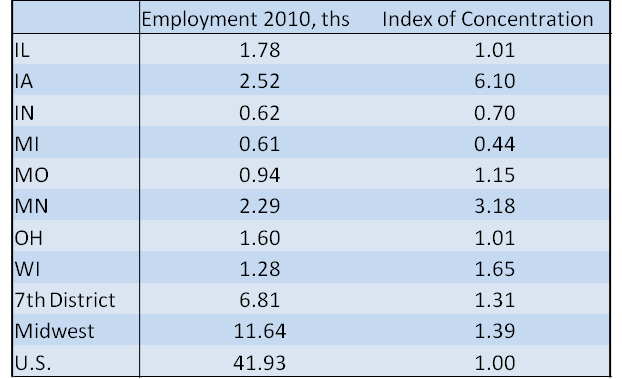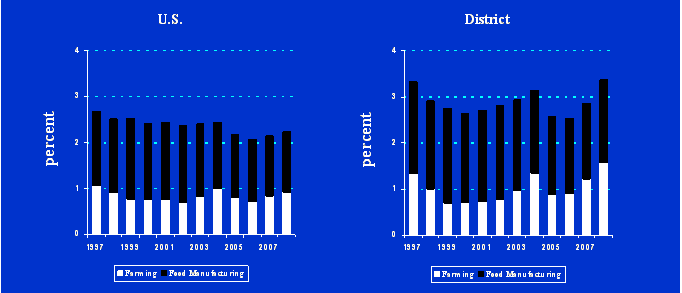Innovation and the District’s Food Industries, and “Clean Tech” Conference Announcement
We all eat, yet the variety of what we eat is mesmerizing. Whether we eat the newest power bar developed in a laboratory or the latest organic, heirloom tomato, innovation is essential to food reaching our mouths. Everyone has a stake in the innovation of the agricultural and food industries—from the inhabitants of the rural Midwest, to the research scientists in our nation’s labs and universities, to people around the world who benefit from pest-resistant strains of grain. Agricultural innovations already have enhanced a wide range of products, including nutritional supplements, plastics, and energy materials derived from production agriculture. The future holds even more promise for benefits derived from the agriculture and food pipelines, especially enhanced nutrition, drought-resistant crops, and new functional foods. However, the safety of the food system remains a vital and ever-present concern, as well as a new source of job creation.
A Regional Strength
It is an interesting feature of regional economies that they often continue to be the innovative centers of the industries that were born there. Perhaps this is not all that surprising, since it is innovation that so often drives and sustains industries—innovation encompassing not only the creation of new products to sustain consumer demand, but also the productivity-enhancing technological improvements to fend off competition from other companies, industries, and countries. Yet, as regions search for their own economic renewal, they may overlook their innovative roots, opting instead to recruit or grow the latest hot sector—be it personal computing equipment, homeland defense, information technology, or biotechnology.
Historically, the Midwest economy is as closely linked with agriculture and the food industry as it is with, say, manufacturing. Indeed, the bountiful production and transport of farm products for export not only supported the region’s employment and income throughout most of its growth and development, but also fed the hordes of factory workers who were once needed to operate the region’s factories and mills.
Today, the innovations of production agriculture remain a legacy feature. Nationally, the identifiable value added from innovation in food processing is significant, though far from the top among industries. According to the most recent National Science Foundation survey (2008), U.S. food companies poured $3.18 billion into R&D domestically and another $683 million abroad.
Such expenditure figures are not publicly available for individual regions. But we can look at the Bureau of Labor Statistics’s occupation data for each state to get a sense of innovation-related employment in agriculture and the food industry. These jobs would include: food scientists and technologists; animal scientists; soil and plant scientists; and agricultural and food science technicians. Moreover, unlike the R&D spending numbers, these employment figures include people across the spectrum from government to university, to nonprofit lab, to private business ventures.
Table 1. Concentrations in selected food industry innovative jobs

Occupational specialties vary from state to state. Also, due to the sample sizes, there are anomalies in the results for specialized occupations for some states. Yet, overall across all of them, the Seventh District states are 31 percent more concentrated in these occupations than the U.S. average; 39 percent more concentrated if we use a broader eight-state definition of the Midwest region (including Minnesota, Missouri, and Ohio). Thus, our region benefits more than the nation from the growth in spending on innovation in the agriculture and food sectors of the economy.
Food Safety is Paramount
As the variety and breadth of our diet expand, so do concerns about food safety. News accounts of foodborne illnessses regularly appear, although the U.S. food system remains among the safest in the world. Public concerns about food safety led to the passage of the Food Safety Modernization Act, signed into law in January 2011. The act will impose new requirements on food manufacturers, processors, packers, distributors, exporters, and importers. It will speed the industry’s movement toward a more science-based food safety system, compelling firms to seek innovative solutions in order to comply and be competitive in dynamic markets.
The academic and government laboratories of the Midwest are important research partners with the private sector. A conference called “Food Safety: Policy Changes, Science-based Opportunities” was held this summer at the Federal Reserve Bank of Chicago as part of a dialog between research institutions and industry in order to further partnerships and generate connections that will improve food safety via innovative technologies and refined systems. It was organized by an array of groups under the auspices of the Global Midwest Alliance.
At the event, David Oppedahl of the Chicago Fed gave an overview of key issues from a regional perspective with regard to food safety. Farming and food manufacturing combined to generate 3.4% of the District’s output in 2008, over 1% more than for the country (see figure 2 at end). Just one form of foodborne illness, salmonella, cost the U.S. economy $2.7 billion in 2010, with almost 1.4 million cases reported. The costs to the nation in medical expenses, lost employment compensation, and premature deaths are significant, although challenging to quantify.
The event’s keynote speaker, Robert Hibbert, K & L Gates L.L.P., compared the food safety system of the 20th Century with that of the 21st Century under the new act. Whereas the former regime involved more reactive regulations and enforcement, the updated food safety system will strive for prevention and traceability. Although resources remain limited, there are plenty of demands on the science and technology: improving process methodologies, enhancing control mechanisms, establishing traceability systems, gathering and exchanging information, and researching virulence in order to establish standards. Challenges to this agenda include the limits of science, expanding the foundation of basic research, communicating risk, and issues with clearances and approvals. Hibbert concluded that firms must “put up with the process,” while at the same time challenging it. An understanding of the emerging regulatory system and business realities will guide the industry toward a safer food supply and improved public health.
A panel on the scientific aspects of food safety was moderated by Paul Sebesta, U.S. Department of Agriculture. The panelists were Rosie Newsome, Institute of Food Technologists, Carla Little, Illinois Department of Public Health, and Todd Ward, U.S. Department of Agriculture. Newsome talked about the Institute’s initiatives and the resources they provide to advance the science of food. Little presented information on her agency’s efforts to ensure a safe food supply for Illinois, while facing increasing complexity in the food chain, globalization, and multi-state outbreaks of foodborne illnesses. Ward outlined the food safety programs at the National Center for Agricultural Utilization Research in Peoria, which focus on developing information and science-based solutions for detecting and removing toxins from food and preventing toxin contamination of food.
Finally, an industry panel, moderated by Matthew Botos, Illinois Science & Technology Coalition, focused on specific firms’ roles in the field of food safety and the opportunities for technological innovators. Justin Ransom, OSI Industries, shared experience gained from running the Food Protection and Quality Systems group, which oversees a global network of food manufacturing plants that handle both raw materials and finished products. Greg West, National Pasteurized Egg Inc., talked about his firm’s rapid growth to meet the demand for safer eggs (especially from restaurants) through innovative technology that maintains the look and taste of fresh eggs while extending shelf life and eliminating salmonella. D. J. Alwattar, Northland Laboratories, outlined his company’s specialized testing expertise, which provides a key component in the industry’s push to meet the challenges of food safety through innovation.
Upcoming Midwest “Clean Tech” Conference Announcement
On September 14, a related meeting at the Federal Reserve Bank of Chicago will focus on innovations in “clean” technology, including those that affect the food industry and agriculture. Organized by the Global Midwest Alliance, “Midwest Clean Tech 2011” will have a particular focus on global issues for innovation partnerships.
Chart 1. U.S. and District output shares from farming and food manufacturing









